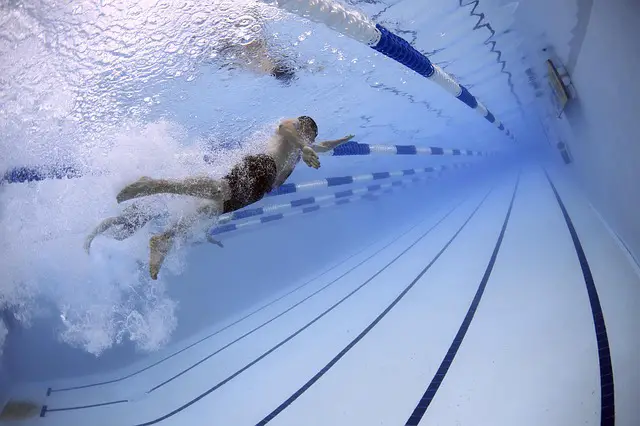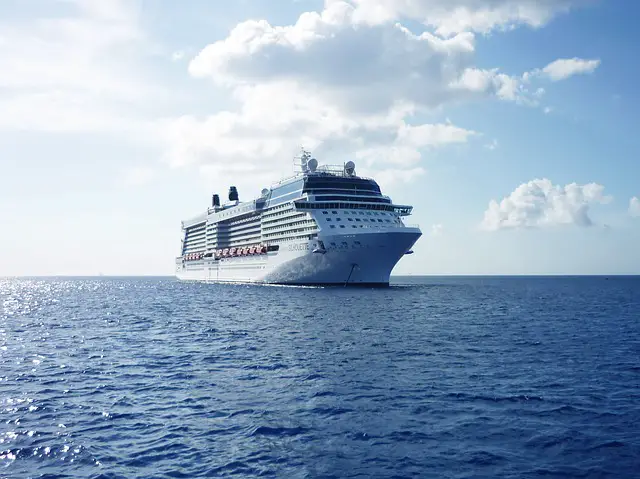Fluid Mechanics

A fluid is a substance that can flow and change its shape since its particles can move around one another.
We know that particles in solid are fixed in a lattice, resulting in their definite shape; hence this is not a fluid. Liquids and gases, however, are fluids since their particles can move freely.
In this reviewer, we are going to learn about fluid mechanics and its properties.
Click below to go to the main reviewers:
Table of Contents
- Density
- Pressure
- Buoyancy
- The Continuity Equation
- Bernoulli’s Principle
- Download Article in PDF Format
- Test Yourself!
Density
All fluids exhibit density, which is the mass per unit volume.
Mathematically,
ρ = m/v
Note that density is represented by the Greek letter, rho, not p. The SI unit for density is kg/cm3.
Objects of the same material have the same density, regardless of their mass and volume.
Sample Problem
If your room has dimensions 3.0 m x 4.0 m and a ceiling 5.0 m high, determine the mass and the weight of the air.
(ρ = 1.20 kg/m3)
Solution
We know that
ρ = m/v
Looking for mass, we will have
m = ρv
The volume of the room is equal to the product of the length, width, and height of the room. Hence,
v = (3.0 m) (4.0 m) (5.0 m)
v = 60 m3
Calculating the mass,
m = ρv
m = (1.20 kg/m3) ( 60 m3)
m = 72 kg
Calculating for the weight,
w = mg
w = (72 kg) (9.8 m/s2)
w = 705.6 N
Pressure
We usually use the term “pressure” to describe the feeling of being pushed, whether by a stressful situation or a physical force. In physics, it almost means the same.
We usually define pressure as the force per unit area. The SI unit for pressure is the pascal (Pa), named after the scientist Blaise Pascal.
The pressure of the earth’s atmosphere is known as atmospheric pressure. This pressure varies with weather changes and with elevation. The normal atmospheric pressure at sea level (an average value) is 1 atmosphere (atm) which is equal to 101,325 Pa.
Pressure in a Liquid

The pressure in a liquid describes how the fluid’s pressure pushes on the walls of the surrounding container, as well as on all parts of the fluid itself. This applies to gases as well, but the pressure in a liquid is a little different from that of a gas.
When you swim underwater, you have probably noticed that the deeper you swim, the greater the pressure you feel since there is more water above you. Hence, the pressure a liquid exerts depends on the depth.
Liquid pressure also increases with depth because of gravity. The liquid at the bottom must bear the weight of all the liquid above it, as well as all the air above that!
You probably do not notice the weight of the air around you because your body is ‘pressurized’ the same as the atmosphere, but any liquid under that atmosphere feels it.
The pressure in the liquid also depends on the density of the liquid. The denser the fluid, the greater the pressure would be.
When a liquid is at rest (not flowing), we can calculate its pressure at the given depth using the formula
p = p0 + ρgh
where
- p is the pressure at depth h in a fluid of uniform density
- p0 is the pressure at the fluid’s surface
- ρ is the uniform density of the fluid
- g is the acceleration due to gravity
- h is the depth below the surface.
When you increase the pressure at the fluid’s surface, the pressure at any depth increases simultaneously. This is known as Pascal’s law.
Sample Problem
Find the density of the gasoline if the pressure inside a tank 8 meters deep is 113,640 Pa. Note that the top of the tank is open to the atmosphere.
Solution
We know that p = p0 + ρgh. Looking for density, we will have
p – p0 = ρgh
Dividing both sides by gh, we will get
ρ = p – p0/gh
Calculating for the density,
ρ = (113640 Pa – 101,325 Pa)/(9.8 m/s2) (8 m)
ρ = 12315 Pa/78.4m2/s2
ρ = 157.08 kg/m3
Buoyancy
Have you ever wondered why it is so hard to push down an object underwater? That is because an upward force exerted by a fluid counteracts your applied force. This upward force is known as buoyancy.
If buoyancy exists, how come other objects sink while others float? Does it have something to do with its size?
The answer lies in the Archimedes principle, which states that objects submerged in a fluid will experience an upward buoyant force equal in magnitude to the weight of the fluid being displaced. The buoyant force supports an object if it is less dense than the fluid since the object’s weight is less than the weight of an equal volume of the fluid.
For example, the cruise ship floats in the ocean because it is less dense compared to the ocean. It may be made up of very dense material like steel, but the air in all the cabins is not dense.

Buoyant force can also be expressed as the gravitational force of the displaced fluid, which is also equal to the mass of the displaced fluid times acceleration due to gravity. In the case of the ship, it weighs less than the water it displaces, causing it to float.
A floating object displaces fluid based on its mass, while a sinking object displaces fluid based on its volume.
Apart from the principle of buoyancy, Archimedes was also the first to understand that when any object is submerged in the water, regardless of its shape, the volume of the water displaced is equal to the volume of the object submerged. His discovery made him run out of the bathtub, shouting “Eureka,” which means “I have found it.”
Buoyant force can also be expressed mathematically. In terms of the equation,
B = ρgv
where
- B is the buoyant force
- ρ is the density of the displaced fluid
- g is the acceleration due to gravity
- v is the volume of the displaced fluid
Sample Problem
Find the buoyant force of a 10 m3 block placed in the water. Note that the density of water is 1000 kg/m3.
Solution
We know that B = ρgv.
Substituting the values, we will get
B = (1000 kg/m3)(9.8 m/s2)(10 m3)
B = 98000 N
The Continuity Equation
Fluids rarely stay at rest; hence, it is important to understand how they flow.
There are varieties of ways a fluid can move, so to understand fluids in a very specific way, we are going to make assumptions. In this lesson, we will assume that fluids are incompressible, flow steadily and constantly, and are non-viscous (no resistance to flow).
When you are watering your plants, you probably have noticed how the water in the hose comes out faster when you block the opening partially. That is because the same volume of water has to travel through the hose, regardless of how small or large the opening is.

The relationship between the area inside the hose (the hose’s internal diameter) and the velocity of the fluid is expressed in the equation of continuity, written mathematically as
A1v1 = A2v2
where A is the area that fluid travels through and v is the velocity of the fluid.
Sample Problem
A hose has an initial cross-sectional area of 1.5 cm2 that expands into 3 cm2. Initially, the velocity of the water through the smaller cross-sectional area of the pipe is ten cm/s. Find the velocity of the water through the larger cross-sectional area section of the pipe.
Solution
We are given the following quantities:
- A1 = 1.5 cm2
- v1 = 10 cm/s
- A2 = 3 cm2
Calculating for the v2,
v2 = A1v1/A2
v2 = (1.5 cm2)(10 cm/s)/3 cm2
v2 = 5 cm/s
Bernoulli’s Principle
Like energy, fluids can also be conserved. This idea is shown in Bernoulli’s principle, which states that a quantity involving the pressure p, flow speed v, and height h has the same value anywhere in a flow tube, assuming steady flow in an ideal fluid.
Mathematically,
p1 + ρgh1 + ½ρv1 2 = p2 + ρgh2 + ½ρv2 2
where
- p is the fluid pressure
- ρ is the fluid density
- g is the acceleration due to gravity (9.8 m/s2)
- h is the height of the fluid off the ground
- v is the velocity of the fluid
Sample Problem
Water flows through a Z-shaped pipe. At one end, the water in the pipe has a pressure of 175 kPa, a speed of 15.0 m/s, and a height of 3.0 m. At the other end, the speed of the water is 5 m/s, and the height is 1.0 m. Find the pressure at this point in terms of kPa. Note that the density of water is 1000 kg/m3.
Solution
Based on Bernoulli’s principle,
p1 + ρgh1 + ½ρv1 2 = p2 + ρgh2 + ½ρv2 2
To find p2,
p2 = p1 + ρg(h1 – h2) + ½ρ(v12 – v2 2)
Substituting the values, we will get
p2 = 175 kPa + (1000 kg/m3) (9.8 m/s2) (3 m – 1 m) + ½ (1000 kg/m3)[(15.0 m/s)2 – (5.0 m/s)2 ]
p2 = 175 kPa + 19600 Pa+ 100000 Pa
p2 = 175 kPa + 19.6 Pa+ 100 kPa
p2 = 294.6 kPa
Next topic: Waves and Optics
Previous topic: Momentum and Impulse
Return to the main article: The Ultimate Physics Reviewer
Download Article in PDF Format
Test Yourself!
1. Practice Questions [PDF Download]
2. Answer Key [PDF Download]
Written by Mary Joy Montenegro
Mary Joy Montenegro
Mary Joy Montenegro is a licensed professional teacher who obtained her Master’s Degree in Teaching Physics at De La Salle University under the Department of Science and Technology Scholarship. Aside from teaching, she also loves traveling and meeting other people.
Copyright Notice
All materials contained on this site are protected by the Republic of the Philippines copyright law and may not be reproduced, distributed, transmitted, displayed, published, or broadcast without the prior written permission of filipiknow.net or in the case of third party materials, the owner of that content. You may not alter or remove any trademark, copyright, or other notice from copies of the content. Be warned that we have already reported and helped terminate several websites and YouTube channels for blatantly stealing our content. If you wish to use filipiknow.net content for commercial purposes, such as for content syndication, etc., please contact us at legal(at)filipiknow(dot)net